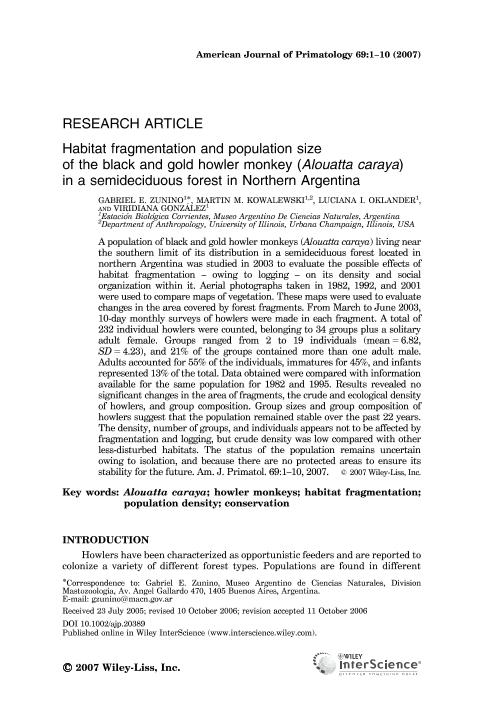Mostrar el registro sencillo del ítem
dc.contributor.author
Zunino, Gabriel Eduardo

dc.contributor.author
Kowalewski, Miguel Martin

dc.contributor.author
Oklander, Luciana Inés

dc.contributor.author
Gonzalez, Viridiana

dc.date.available
2021-05-26T12:19:33Z
dc.date.issued
2007-09
dc.identifier.citation
Zunino, Gabriel Eduardo; Kowalewski, Miguel Martin; Oklander, Luciana Inés; Gonzalez, Viridiana; Habitat Fragmentation and Population Size of the Black and Gold Howler Monkey (Alouatta caraya) in a Semideciduous Forest in Northern Argentina; Wiley-liss, div John Wiley & Sons Inc.; American Journal Of Primatology; 69; 9; 9-2007; 966-975
dc.identifier.issn
0275-2565
dc.identifier.uri
http://hdl.handle.net/11336/132548
dc.description.abstract
A population of black and gold howler monkeys (Alouatta caraya) living near the southern limit of its distribution in a semideciduous forest located in northern Argentina was studied in 2003 to evaluate the possible effects of habitat fragmentation - owing to logging - on its density and social organization within it. Aerial photographs taken in 1982, 1992, and 2001 were used to compare maps of vegetation. These maps were used to evaluate changes in the area covered by forest fragments. From March to June 2003, 10-day monthly surveys of howlers were made in each fragment. A total of 232 individual howlers were counted, belonging to 34 groups plus a solitary adult female. Groups ranged from 2 to 19 individuals (mean = 6.82, SD = 4.23), and 21% of the groups contained more than one adult male. Adults accounted for 55% of the individuals, immatures for 45%, and infants represented 13% of the total. Data obtained were compared with information available for the same population for 1982 and 1995. Results revealed no significant changes in the area of fragments, the crude and ecological density of howlers, and group composition. Group sizes and group composition of howlers suggest that the population remained stable over the past 22 years. The density, number of groups, and individuals appears not to be affected by fragmentation and logging, but crude density was low compared with other less-disturbed habitats. The status of the population remains uncertain owing to isolation, and because there are no protected areas to ensure its stability for the future.
dc.format
application/pdf
dc.language.iso
eng
dc.publisher
Wiley-liss, div John Wiley & Sons Inc.

dc.rights
info:eu-repo/semantics/openAccess
dc.rights.uri
https://creativecommons.org/licenses/by-nc-sa/2.5/ar/
dc.subject
ALOUATTA CARAYA
dc.subject
CONSERVATION
dc.subject
HABITAT FRAGMENTATION
dc.subject
HOWLER MONKEYS
dc.subject
POPULATION DENSITY
dc.subject.classification
Otros Tópicos Biológicos

dc.subject.classification
Ciencias Biológicas

dc.subject.classification
CIENCIAS NATURALES Y EXACTAS

dc.title
Habitat Fragmentation and Population Size of the Black and Gold Howler Monkey (Alouatta caraya) in a Semideciduous Forest in Northern Argentina
dc.type
info:eu-repo/semantics/article
dc.type
info:ar-repo/semantics/artículo
dc.type
info:eu-repo/semantics/publishedVersion
dc.date.updated
2021-04-28T21:43:32Z
dc.journal.volume
69
dc.journal.number
9
dc.journal.pagination
966-975
dc.journal.pais
Estados Unidos

dc.description.fil
Fil: Zunino, Gabriel Eduardo. Consejo Nacional de Investigaciones Científicas y Técnicas. Oficina de Coordinación Administrativa Parque Centenario. Museo Argentino de Ciencias Naturales "Bernardino Rivadavia". Estación Biológica de Usos Múltiples (Sede Corrientes); Argentina
dc.description.fil
Fil: Kowalewski, Miguel Martin. Consejo Nacional de Investigaciones Científicas y Técnicas. Oficina de Coordinación Administrativa Parque Centenario. Museo Argentino de Ciencias Naturales "Bernardino Rivadavia". Estación Biológica de Usos Múltiples (Sede Corrientes); Argentina. University of Illinois at Urbana; Estados Unidos
dc.description.fil
Fil: Oklander, Luciana Inés. Consejo Nacional de Investigaciones Científicas y Técnicas. Oficina de Coordinación Administrativa Parque Centenario. Museo Argentino de Ciencias Naturales "Bernardino Rivadavia". Estación Biológica de Usos Múltiples (Sede Corrientes); Argentina
dc.description.fil
Fil: Gonzalez, Viridiana. Consejo Nacional de Investigaciones Científicas y Técnicas. Oficina de Coordinación Administrativa Parque Centenario. Museo Argentino de Ciencias Naturales "Bernardino Rivadavia". Estación Biológica de Usos Múltiples (Sede Corrientes); Argentina
dc.journal.title
American Journal Of Primatology

dc.relation.alternativeid
info:eu-repo/semantics/altIdentifier/url/https://onlinelibrary.wiley.com/doi/abs/10.1002/ajp.20389
dc.relation.alternativeid
info:eu-repo/semantics/altIdentifier/doi/http://dx.doi.org/10.1002/ajp.20389
Archivos asociados
